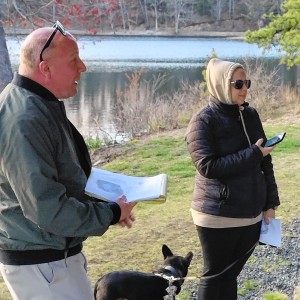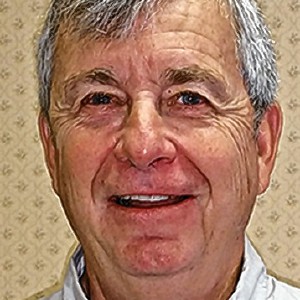Overdose survivor, researcher leads talk on adulterants in drug supply
| Published: 01-27-2023 3:44 PM |
The Opioid Task Force of Franklin County and the North Quabbin Region hosted a virtual training on Wednesday led by the overdose survivor and researcher who made headlines recently after the Massachusetts Registry of Motor Vehicles reversed its decision denying him a license plate bearing the word “NARCAN,” the brand name for a medication that can reverse an opioid overdose.
Stephen Murray, also a national harm reduction speaker and former paramedic, walked attendees through a slideshow presentation on advanced overdose response and adulterants making their way into the drug supply. He said he suspects heroin and other opioids are being cut with substances — including fentanyl, xylazine and quinine — not by the leaders of drug cartels, but by the last street-level dealer.
“This is how, I believe, that it’s happening, sort of at the local level,” Murray explained.
He said heroin’s duration of action, or the amount of time a drug’s effect lasts, is three to four hours, which requires injecting six to eight times per day, or 56 times per week. Fentanyl, a powerful synthetic opioid similar to morphine but 50 to 100 times more potent, has a shorter duration of action of roughly 30 to 60 minutes, and current participants in syringe exchange programs report injecting up to 18 times per day, or 150 times per week.
However, Murray said, needles are designed to be used only once, and repeated use can cause damage to the skin, soft tissue and veins. Reusing needles can increase infection risk by introducing bacteria. These infections can lead to abscesses, cellulitis and sepsis, all of which can be life-threatening if untreated.
But Murray stressed fentanyl cannot be absorbed through the skin in powder form or made airborne sufficiently enough to present an inhalation danger. He showed body camera footage and television news reports of police officers being saved by colleagues after apparently overdosing by absorbing or inhaling fentanyl, but said those officers actually experienced panic attacks that were triggered by fear about being told they were in the presence of fentanyl.
Murray also spoke about the importance of naloxone, known by the brand name Narcan, which can reverse the effects of an opioid overdose.
As someone in recovery himself, Murray applied for a vanity license plate reading “NARCAN” last year, hoping to raise awareness of the lifesaving medication while sitting in Boston-area traffic. However, in November he posted to Twitter a photo of a rejection letter in which the Registry of Motor Vehicles denied his application because the word was “vulgar in that it is in poor taste or is degrading or is considered a profanity, including a swear or curse word, not usually displayed in the community for general viewing.”
Article continues after...
Yesterday's Most Read Articles
 Plan calls for upgrades to Silver Lake in Athol
Plan calls for upgrades to Silver Lake in Athol
 Magic comes to Red Apple in Phillipston
Magic comes to Red Apple in Phillipston
 Parents question handling of threat at Erving Elementary School
Parents question handling of threat at Erving Elementary School
 On The Ridge with Joe Judd: What time should you turkey hunt?
On The Ridge with Joe Judd: What time should you turkey hunt?
 Erving rejects trade school’s incomplete proposal for mill reuse
Erving rejects trade school’s incomplete proposal for mill reuse
 Orange man gets 12 to 14 years for child rape
Orange man gets 12 to 14 years for child rape
Murray decided to fight this decision — as the state agency had approved of “BOTOX,” “BOOGER,” “WTF,” “BEDBUG” and “GASSY” — and ultimately won earlier this month.
At Wednesday’s training, he also touched on a topic the regional opioid task force has been emphasizing — the increase of xylazine, a veterinary sedative, in the local illicit drug supply. He reported that 77% of all opioid samples in western Massachusetts from May 1 to June 15 contained xylazine. That figure was 25% in the eastern part of the state. Murray said xylazine is being cut into fentanyl to prolong highs, but that it leads to compartment syndrome and fatal overdoses. He also said it causes extreme sedation, which often leads to sexual assault and rape.
People who use intravenous drugs cut with xylazine can also develop necrosis, or tissue death, at the injection site because it was not created to be used intravenously or by humans.
Misuse of xylazine was first reported in Puerto Rico in the early 2000s, Murray said.
“Everything we know about xylazine we know from Puerto Rico,” he said, elaborating that the U.S. island territory has a vibrant horse culture and, therefore, a prevalence of large-animal sedatives for veterinary treatment. “We are sort of learning as we go with xylazine,” he said.
Murray also mentioned quinine, which has been used to treat malaria, has been found in the drug supply since at least 1970. He explained it is a brown powder that mimics heroin’s bitter taste. Indicators of quinine toxicity include blurred vision, blood in urine, hearing loss, vomiting, chest pain and seizures.

 Students plant red maple outside Athol Community Elementary School
Students plant red maple outside Athol Community Elementary School Mass Dems propose nine-month shelter stay limit
Mass Dems propose nine-month shelter stay limit Federal probe targets UMass response to anti-Arab incidents
Federal probe targets UMass response to anti-Arab incidents Sportsman’s Corner: Missouri gobbler
Sportsman’s Corner: Missouri gobbler